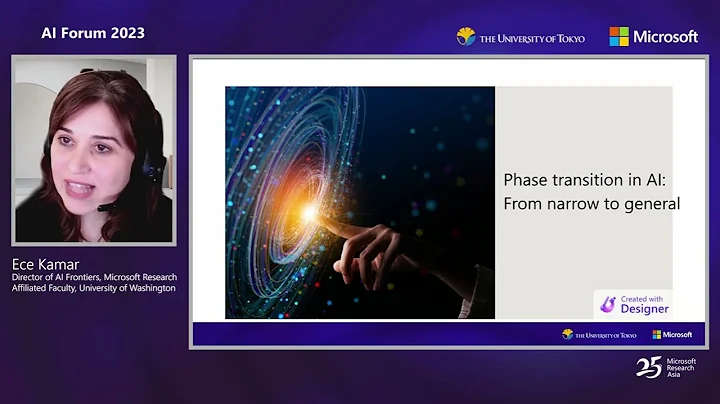Unveiling Bias in Machine Learning
Table of Contents
Understanding Bias in Machine Learning Models
- Introduction to Bias in Machine Learning
- Impact of Bias in Computer Vision
- Challenges in Identifying Bias
- Overcoming Data-Related Bias
- Addressing Model Confidence
- Measuring Bias in Models
- Quantifying Bias in Training Data
- Evaluating Model Confidence
- Strategies to Mitigate Bias
- Bayesian Methods in Deep Learning
- Visualization Techniques for Model Interpretation
- Future Directions and Research Questions
- Evaluating Bias without Real Data
- Ensuring Model Confidence Accuracy
- Extending Face Recognition Models
Understanding Bias in Machine Learning Models
In the realm of machine learning, understanding bias is paramount to building fair and effective models. Bias, in this context, refers to the systemic errors or inaccuracies Present in training data or model predictions that can lead to unfair outcomes. Particularly in computer vision, where algorithms interpret visual data, bias can manifest in various forms, impacting the accuracy and fairness of model predictions.
Impact of Bias in Computer Vision
The implications of bias in computer vision are far-reaching. Consider a Scenario where an Image Recognition model misclassifies certain demographics more frequently than others. Such biases can perpetuate societal inequalities and lead to unjust outcomes, especially in applications like facial recognition technology, where misidentification can have serious consequences.
Challenges in Identifying Bias
Identifying bias poses significant challenges, primarily rooted in the complexities of data collection and model interpretation. One major hurdle lies in mitigating biases inherent in training data, which may reflect historical inequities or societal prejudices. Additionally, assessing the confidence levels of machine learning models presents another obstacle, as overconfidence can lead to erroneous predictions.
Overcoming Data-Related Bias
To address data-related bias, researchers advocate for strategies such as diversifying training datasets, actively mitigating sample selection biases, and employing techniques like data augmentation to enhance model robustness against biased inputs.
Addressing Model Confidence
Ensuring accurate model confidence is equally critical. Techniques such as calibration, where model predictions Align with their true probabilities, and post-processing methods like Platt scaling can help refine confidence estimates, reducing the risk of overconfident yet erroneous predictions.
Measuring Bias in Models
Quantifying bias in machine learning models necessitates robust metrics that capture disparities in model performance across different demographic groups. Recent approaches involve comparing prediction accuracies between groups based on sensitive attributes like race or gender, aiming to detect and mitigate biased behaviors.
Quantifying Bias in Training Data
One method involves measuring the difference in accuracy between demographic groups, identifying disparities indicative of biased training data. Metrics like the area under the ROC curve provide a standardized measure of bias, enabling fairer evaluations of model performance.
Evaluating Model Confidence
Assessing model confidence entails scrutinizing the disparity between predicted probabilities and actual outcomes. By calibrating model confidence to reflect true uncertainty, practitioners can enhance the reliability of model predictions, mitigating the impact of overconfident yet inaccurate assessments.
Strategies to Mitigate Bias
Mitigating bias requires multifaceted approaches, ranging from algorithmic interventions to interpretability techniques that elucidate model decision-making processes.
Bayesian Methods in Deep Learning
Applying Bayesian methods to deep neural networks offers a promising avenue for bias reduction. By incorporating prior knowledge and uncertainty estimation into model training, Bayesian approaches facilitate more nuanced decision-making, mitigating the risk of biased predictions.
Visualization Techniques for Model Interpretation
Visualizing model embeddings and decision boundaries provides invaluable insights into model behavior, aiding in the identification and remediation of biased Patterns. Techniques such as t-SNE visualization enable practitioners to explore high-dimensional data spaces, uncovering Hidden biases and informing model refinement strategies.
Future Directions and Research Questions
Despite recent advancements, numerous research questions remain unanswered, underscoring the ongoing need for innovative solutions to mitigate bias in machine learning models.
Evaluating Bias without Real Data
Exploring methods to evaluate model bias without relying on real-world data presents an intriguing challenge. By leveraging synthetic data or simulation techniques, researchers aim to assess bias in models independently of external datasets, enhancing the robustness and generalizability of bias evaluations.
Ensuring Model Confidence Accuracy
Improving the accuracy of model confidence estimates remains a pressing concern. Developing techniques to calibrate model confidence and mitigate overconfidence is essential for enhancing the reliability and fairness of machine learning systems.
Extending Face Recognition Models
Expanding the capabilities of face recognition models to recognize non-human faces represents a promising frontier. By training models on diverse datasets encompassing various object classes, researchers aim to minimize biases stemming from limited training data, paving the way for more inclusive and equitable computer vision systems.
Highlights
- Understanding the complexities of bias in machine learning is essential for building fair and effective models.
- Bias in computer vision can perpetuate societal inequalities and lead to unjust outcomes, underscoring the importance of addressing bias in model development.
- Identifying and mitigating biases in training data and model predictions present significant challenges, necessitating innovative approaches and robust evaluation metrics.
- Strategies such as Bayesian methods and visualization techniques offer promising avenues for mitigating bias and enhancing model interpretability.
- Future research directions include exploring Novel methods for evaluating bias, improving model confidence accuracy, and extending the capabilities of face recognition models to mitigate biases.
Frequently Asked Questions
Q: How does bias manifest in machine learning models?
A: Bias can manifest in various forms, such as disparities in model performance across different demographic groups or overconfidence in model predictions, leading to unfair outcomes and perpetuating societal inequalities.
Q: What challenges are associated with mitigating bias in machine learning models?
A: Mitigating bias requires addressing complexities in data collection, model training, and evaluation. Challenges include identifying and mitigating biases in training data, ensuring accurate model confidence estimates, and developing interpretable techniques to elucidate model decision-making processes.
Q: What future research directions are crucial for advancing bias mitigation in machine learning models?
A: Future research should focus on developing innovative methods for evaluating bias without relying on real-world data, improving the accuracy of model confidence estimates, and extending the capabilities of face recognition models to recognize non-human faces. These efforts are essential for fostering fairness, transparency, and inclusivity in machine learning systems.

 179.4K
179.4K
 14.01%
14.01%
 26
26


 5.3K
5.3K
 18.88%
18.88%
 2
2


 90.8K
90.8K
 50.53%
50.53%
 4
4


 < 5K
< 5K
 1
1


 1M
1M
 44.54%
44.54%
 1
1




































